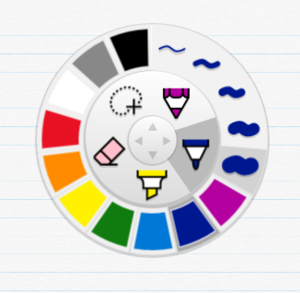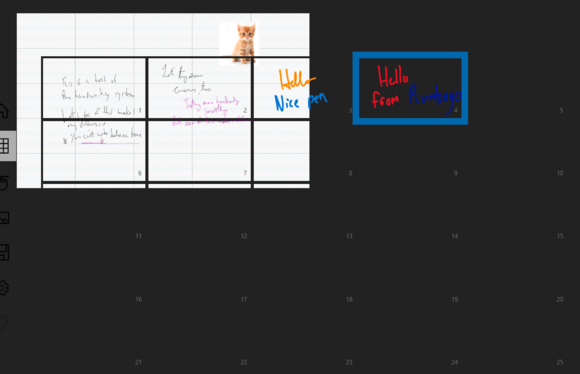
In concept, it sounds useful: a Microsoft Garage app that promises to smooth, or “beautify,” your handwriting when you take notes on a Windows 8.1 or Windows 10 tablet, such as the Microsoft Surface. Unfortunately, Plumbago’s smoothing feature doesn’t seem to work, yet.
Think of Plumbago as a stripped-down version of OneNote, with an emphasis on easy doodling and adding art. (Mary Jo Foley made the analogy that Plumbago is to OneNote as Sway is to Word, which isn’t far off.)
In execution, Plumbago is pretty simple: You can configure a “notebook” of up to 25 pages, with custom backgrounds for each page. One of these happens to be a “lined paper” background, which should take men and women of a certain age back to their grammar school days.
The lined paper background and a “handwriting smoothing” scrollbar—basically the only setting available—inidcate that Plumbago is for people who prefer to take handwritten notes on a tablet. On the Surface, that role is filled by OneNote; you can press the button on the Surface stylus to launch the app, even from sleep. But as simple as OneNote is, there’s an apparent risk of getting lost in its interface, with notebooks and other embeddable objects crowding the view.
 MARK HACHMAN
MARK HACHMANPlumbago keeps it simple: The radial menu makes selecting a virtual pen or pencil extremely easy, and the “ink” acts like real ink or graphite on real paper. You can import images into the notebook, but only from files stored on your computer. (Sway, by contrast, brings an image discovery tool right inside the app.)
As an experimental Microsoft Garage project, Plumbago is expected to have some quirks. And yes, that’s indeed thecase.
One issue I found was the inability for the ink to recognize portrait mode, the most natural way (for me) to take notes on a tablet. While the page covered the length of the my Surface Book’s screen, the ink stopped being recognized midway down.

MARK HACHMAN
More troubling, the handwriting smoothing feature—Plumbago’s primary selling point—did nothing for me at all. I tried out Plumbago on a Surface Book in tablet mode as well as aSurface Pro 4; adjusting the handwriting smoothing slider bar up or down made no noticeable difference, even after saving and reopening the notebook. I’m not sure if I was simply using it incorrectly, or if the feature is actually broken. Needless to say, it was very disappointing.
Microsoft, however, said that the handwriting smoothing is there — it’s just more subtle than you might think.
“Plumbago released through the Microsoft Garage as an experiment in order to understand how people want to use it,” Gavin Jancke, general manager of engineering inMicrosoft Research and the de facto user interface software engineer for the app, said in an emailed statement. “Feedback like yours is exactly what we need to tune the app to work the way our customers want it to work. In this prototype, the handwriting beautification settings are subtle. The effect is more obvious in certain characters. The editor can more visually see the effect by drawing a line of cursive ‘e’s such as at the end of the tutorial video.”
One of the tips I was given as a young reporter was to toss out my old notebooks after a period of time, as a hedge against being asked to testify in a court case. My real fear, however, was being asked to read my notes, as my handwriting has progressively degraded over the years. Today, I can simply record someone’s voice on my phone, take a picture, or type notes using my PC. But I’ve always felt that I could scrawl a note on mytablet in a pinch. I’m just not sure that at this point it will be with Plumbago.
Updated at 1:52 PM with comments from Mi
[“source -cncb”]
